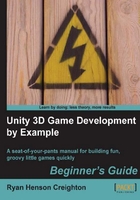
上QQ阅读APP看书,第一时间看更新
Chapter 1 was all about getting a feel for what Unity can do and for what the program interface had to offer. Here's what we found out:
- Massive 80 person teams, all the way down to tiny one- or two-person teams are using Unity to create fun games.
- By thinking small, we'll have more success in learning Unity and producing fully functional games instead of huge but half-baked abandoned projects.
- Different flavors of Unity help us deploy our games to different platforms. By using the free indie version, we can deploy to the Web, and the Mac and PC platforms.
- The Unity interface has controls and panels that let us visually compose our game assets, and test games on the fly right inside the program!
I hope you've taken some time to thoroughly vandalize the Island Demo. Save the file by clicking on File | Save Project in case you want to come back and wreak more havoc a little later.
Now that we've trashed this joint, let's take a quick trip through some game design theory. In the next chapter, we'll figure out the scope and scale of a game that a solo, beginner developer should actually tackle. Crack your knuckles and put on your favorite hat because you're about to dip yourself in awesome sauce.